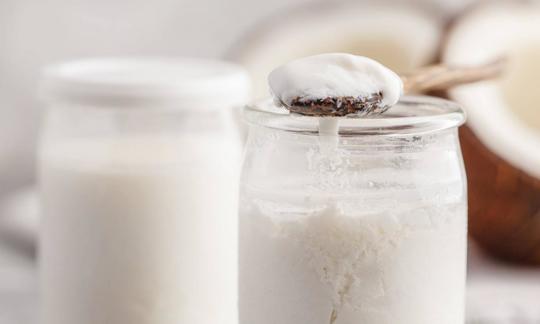Table of contents
Coconut yoghurt is a yoghurt-like product made from coconut milk using the classic yoghurt bacteria cultures (such as Streptococcus thermophilus, Lactobacillus bulgaricus ). Raw organic coconut yoghurt is easy to make yourself.
Use in the kitchen
Coconut yoghurt can be used in many different ways. It is suitable as a vegan yoghurt substitute for morning muesli, for overnight oats or tastes delicious mixed with fresh fruit. The acidified coconut product can also be used to decorate or refine vegan cakes, tarts, creams or other cold desserts. Cow's milk yoghurt can easily be replaced with coconut yoghurt in cakes, muffins or in the well-known mango lassi. Vegan 'frozen yoghurt' can also be made with coconut yoghurt - puree frozen fruit (e.g. mango or strawberries ) with the yoghurt. Smoothies can also be refined with coconut yoghurt. Coconut yoghurt can also be used in spicy sauces, dips, spreads, soups or curries .
It should be noted that coconut yoghurt has a high fat content (saturated fats!) and meals enriched with it have a higher nutritional value. Therefore, yoghurt made from coconut milk should be used sparingly. In addition to soy yoghurt, there are other vegan alternatives made from oat milk or almond milk .
The taste of coconut yoghurt is mild to sour, depending on the product and production method. The often high fat content makes it appear creamy and smooth.
Homemade preparation (make your own coconut yoghurt)
Coconut yoghurt is easy to make yourself with just a few ingredients. For 1 kg of coconut yoghurt you need 800 ml of organic coconut milk from a can, 1-2 teaspoons of agar-agar (as a thickener) and yoghurt starter cultures (this ferment contains lactic acid bacteria such as Streptococcus thermophilus, Lactobacillus bulgaricus ). You can also try it without thickeners, but vegan yoghurt is more liquid than that made from cow's milk. The last two ingredients are available in health food stores, drugstores or online. Since purchased organic coconut milk is usually pasteurized, coconut yoghurt made from purchased coconut milk is not considered raw in the sense of raw food.
To ensure that the fat in the coconut milk mixes better with the water it contains, it is advisable to store the canned product at room temperature overnight. The coconut milk can then be mixed perfectly with a hand mixer. Take around 100-200 g of it, put it in a pot and mix it with agar-agar. The mixture must now simmer for around 2 minutes, don't forget to stir. Add the cooled (!) coconut milk-agar-agar mixture to the rest of the coconut milk and mix well again with the mixer. The temperature must not be above 45 °C when adding the starter cultures, otherwise the lactic acid bacteria will die. Stir well again after adding the ferment.
If you have a yogurt maker, pour the coconut milk into it and leave it to rest for 14-18 hours. If you don't have one, you can also prepare the culture in the oven. To do this, set the oven to 40 °C, maximum 45 °C. Often, just turning on the light is enough, as the light bulb produces enough heat. The temperature can be easily measured with a room thermometer. The yogurt, filled into screw-top or swing-top jars, is also left to stand in the oven for 14-18 hours.
It is also possible to place the yoghurt over the heater, but it is difficult to keep the required 40 °C constant. The shorter the fermentation time, the milder and more liquid the yoghurt is; the longer, the more sour it tastes. After fermentation, the yoghurt is placed in the fridge for about a day, because it only gets a typically solid yoghurt consistency when it cools down. 2 In principle, it is possible to reuse 100 g of the yoghurt as a starter culture for the next round of coconut yoghurt. However, this requires a high degree of purity and only works if the starting culture has enough "food" until the next production process. The cold in the fridge slows down the activity of the lactic acid bacteria, but does not stop it. This is also essential so that the bacteria can "start up" again the next time it is used.
Tips: On hot summer days, the yoghurt may not turn out well and may "spoil" (go bad). Other possible thickeners such as locust bean gum, guar gum or tapioca starch are suitable for cold preparation. In addition to agar-agar, arrowroot starch, corn starch, potato starch or pectin have also proven useful for boiling. It is also important to keep to the resting times and not to "watch how the yoghurt is doing" because movement can disrupt the fermentation.
Alternatively, you can also make the yoghurt in raw food quality:
Ingredients: 1 young coconut, 4 probiotic capsules.
Preparation: Open the young coconut. You can find instructions under the ingredient coconut . Puree the coconut water and jelly in a blender until you have a homogeneous mass. Now open the probiotic capsules and add the powder. Mix everything well again. You can now fill the coconut yoghurt into screw-top jars, making sure that you only fill the jars about 2⁄3 full. The good probiotic bacteria need space to multiply, which allows the yoghurt to rise. Cover the jars with a cotton cloth so that gases can escape. The coconut yoghurt needs about 12 hours to ferment in a warm place (as described above). After this, the yoghurt should be firmer, creamier, and about 1⁄3 larger. Close the jars and store the yoghurt in the refrigerator to slow down the fermentation.
Vegan recipe for coconut yoghurt and bean hummus
Ingredients: 1 bulb of garlic, 1 tbsp olive oil (alternatively rapeseed oil ), 1 can of cooked white beans (or cook them yourself after soaking ), 6 tbsp coconut yoghurt, lime juice (from 1⁄2 lime ) and lime zest, 1 tsp cayenne pepper, 1⁄2 tsp salt .
Preparation: Preheat the oven to 200 °C fan. Cut off the top of the garlic bulb, expose some of the cloves and drizzle with oil. Bake the bulb in the oven for 35-40 minutes until soft (ideally covered in a small ovenproof casserole dish with a lid). Drain the cooked beans from the tin/jar and puree them with the (peeled) garlic, coconut yoghurt, lime zest, lime juice, cayenne pepper and salt in a high-performance blender or with a hand blender until fine. Put the creamy hummus in a bowl and sprinkle with cayenne pepper.
Vegan recipes with coconut yoghurt can be found under the note: " Recipes that have the most of this ingredient ".
| Not only vegans or vegetarians should read this: Vegans often eat unhealthily. Avoidable nutritional errors . |
Purchasing - Storage
You can get coconut products similar to yogurt at Coop, Migros, Denner, Volg, Spar, Aldi, Lidl, Rewe, Edeka, Hofer, Billa etc., mostly in organic quality. You can find different types of organic coconut yogurt in health food stores, organic shops and organic supermarkets (e.g. Denn's Biomarkt or Alnatura ). These products are not raw, in the sense of raw food.
Commercial products can vary greatly in consistency (from solid and lumpy to almost liquid), taste and price. Those that taste very intensely of coconut often have an above-average sour note. That's why it's best to try the products and only then decide what vegan coconut yoghurt you want to use for. Coconut yoghurt is also available ready-made in different flavors, but the sugar content is often significantly higher.
The availability of coconut yoghurt varies depending on the size of the store, catchment area, etc. You can find our recorded food prices for the DA-CH countries above under the ingredient image - and by clicking you can see their development at different suppliers.
Storage tips
Homemade coconut yoghurt can be kept in the fridge for around 5-7 days after opening. If you buy yoghurt, please read the best-before date on the packaging. Opened products should be consumed within a few days.
Ingredients - nutritional values - calories
The ingredients of coconut yoghurt can vary from product to product, depending on the recipe. For example: homemade coconut yoghurt can have different ingredients depending on the starting product. Coconut milk has a fat content of around 21 g/100g and coconut meat (ripe) 33 g/100g. Homemade yoghurt made from young coconut meat (coconut jelly) fares a little better. Young coconut meat has "only" 6 g/100g. The fats in all ingredients consist mainly of saturated fatty acids. 1
Here we give the values of a commercially available coconut yoghurt:
It contains 7.7 g fat (7.1 g saturated fat), 5.9 g carbohydrates and 0.7 g protein per 100 g. This gives the yoghurt 95 kcal/100g. 24
Vitamins are contained in negligible quantities. However, coconut yoghurt does offer some minerals: manganese is the most important with 0.30 mg/100g. This value is comparable to Medjool dates or oat milk . Cashew nuts (1.7 mg/100g) and almonds (2.2 mg/100g) contain much more. 24
Coconut yogurt also provides potassium (180 mg/100g), in a similar concentration to semolina or cooked quinoa . Among others, pistachios (1025 mg/100g) or hazelnuts (680 mg/100g) have a higher potassium content. 24
It also contains some sodium (72 mg/100), magnesium (31 mg/100g) and calcium (39 mg/100g). 24
In a scientific comparison of different yoghurts ( almond, oat, reduced-fat and full-fat yoghurt, cashew and coconut), coconut yoghurt had the highest energy content (kcal) and the lowest nutrient density. 6
You can find all the ingredients of coconut yoghurt, the coverage of the daily requirement and comparison values with other ingredients in our nutrient tables. In the article Nutrients explained you will get a detailed insight into the topic.
Effects on health
Is coconut yoghurt healthy? The health value of coconut yoghurt is controversial, as is the case with other coconut products. In general, there is currently insufficient scientific evidence for a positive, health-promoting effect of coconut products. The high content of saturated fatty acids is worrying. These increase (bad) LDL cholesterol and can lead to cardiovascular disease if consumed in excess. 14, 16
LDL cholesterol is a major cause of atherosclerosis because it dumps its cholesterol load onto the artery wall, causing blockages and inflammation. Yet coconut oil has received a lot of attention in the popular media as a potentially healthy food. In fact, a 2016 survey found that 72% of Americans view coconut oil as a healthy food. This is a notable marketing success of the coconut oil and related industries, which promote coconut oil as a natural, healthy product; even though it is known to raise LDL cholesterol. 14
Coconuts do contain a special type of saturated fat (there are many different types of fats) called medium-chain fatty acids (mainly lauric acid). Lauric acid is often classified as a medium-chain fatty acid and is considered to be like shorter-chain fatty acids with 6, 8 or 10 carbon atoms. However, lauric acid (12 carbon atoms) acts biologically like a long-chain fatty acid and increases LDL cholesterol. True medium-chain fatty acids have no effect on LDL cholesterol. Coconut oil contains about 13% true medium-chain fatty acids with 6, 8 or 10 carbon atoms. Classifying lauric acid as a medium-chain fatty acid is therefore incorrect and contradicts its biological action as a long-chain fatty acid. 14
Sometimes it is important to look at the secondary plant substances in order to be able to estimate the effects on health. Coconuts do contain secondary plant substances (phenols) that have an antioxidant effect, but the content is low compared to other products. A study of coconut meat found a total phenol content of 62.8-100.1 µg GAE/g FW. 8,9 For comparison, almonds, which can also be processed into yoghurt, have a total phenol content of 1270-2410 µg GAE/g FW. 10 GAE describes a standard calibration for measuring the total phenol content: GAE = gallic acid equivalent per g FW (fresh weight). 8 Fermentation can increase the antioxidant effect. However, we were unable to find precise data on this. 11
The positive thing about coconuts is that they provide a lot of energy (in the form of saturated fats) and clean water (coconut water) in the growing areas. Coconut yogurt also contains probiotics, which have been proven to be good for us. 11 Consumption of probiotic yogurt is associated with positive effects on the cardiovascular system, metabolism, obesity, diabetes, oxidative stress, inflammation and cholesterol levels. 12,13 Probiotics are therefore considered healthy; however, coconut yogurt should be considered an occasional luxury item due to its high fat content.
Coconut yogurt (consumed in moderation) is a good substitute for soy yogurt if you are allergic to soy, or for cow's milk yogurt if you are lactose intolerant. Alternatively, you can also make vegan yogurt from other plant-based drinks such as oat drink (oat milk) or almond drink (almond milk) .
You can also find study results and our assessment for other ingredients such as coconut meat, coconut oil or coconut milk .
Dangers - Intolerances - Side effects
Saturated fats promote an increase in cholesterol levels, which promotes heart disease and strokes. 25 In general, saturated fatty acids have a detrimental effect on blood values and cholesterol levels. In addition to coconut fat (82%), palm oil (approx. 49%) and cocoa butter (approx. 60%) are plant products that are rich in saturated fatty acids. When coconut fat or coconut oil is consumed, the undesirable LDL cholesterol in the blood increases, which promotes cardiovascular disease. However, the healthy HDL increases a little more, which then improves the total/HDL serum cholesterol ratio. Measured only by this ratio and ignoring it, coconut fat appears healthier, which is a fallacy. A 2016 study analyzed 21 research papers, including 8 clinical studies and 13 observational studies, and concluded that replacing coconut oil with a healthier oil reduces the risk of cardiovascular disease. 4
The praise of the high proportion of medium-chain fatty acids (MCT) should also be treated with caution. It is true that our body can absorb them more easily from the gastrointestinal tract into the bloodstream, which is why they are mainly used in patients with digestive and absorption disorders who suffer from energy deficiency and impaired fat absorption. But apart from that, the disadvantages outweigh the advantages, especially when you consider that extra-enriched MCTs are often used for the aforementioned medical conditions and not pure coconut oil. Experts also recommend the use of MCTs only for strictly specified medical indications. 5
Allergies to coconut products are very rare. A coconut allergy is also not, as the name suggests, related to a general nut allergy. 17
Ecological footprint - animal welfare
Global food production is responsible for approximately 26% of all annual greenhouse gas emissions. One of the biggest drivers is dairy products. 18,22
In our research, we were unable to find any precise data (numbers) on the ecological impact of coconut yoghurt. Therefore, to estimate the values of other coconut products: Coconut milk has a CO 2 footprint of 3.5 kg CO 2 eq/kg, with agricultural practices accounting for the largest share. 19 Coconut oil has a CO 2 footprint of 2.3 kg CO 2 eq/kg. Organic cow's milk yoghurt in a plastic cup with paper wrapping has a CO 2 footprint of around 1.9 kg CO 2 eq/kg; soy yoghurt in the same packaging only has 0.6. 21
The Global average water footprint of coconuts is 2687 l/kg. 20
For comparison: oat flakes, which can also be used to make plant milk and yoghurt, pollute the environment with only 0.95 kg CO 2 eq/kg. 19 The water footprint is also slightly better at 2416 l/kg. 20
Coconut production poses a number of serious ecological problems. As palm oil fell into disrepute, coconuts were touted as a good alternative. However, coconuts produce less per hectare than oil palms. Coconut palms grow under the same tropical conditions as oil palms and to meet the high demand, rainforests are being cleared to make room for coconut monocultures. This results in massive CO 2 emissions and loss of biodiversity. 16,23
In addition, trained monkeys (macaques) are often used to harvest coconuts. 26 For more information, see Coconut meat .
Worldwide occurrence - cultivation
The largest producers of coconuts worldwide are Indonesia and the Philippines, followed by India in third place. About 70% of global coconut production comes from these three countries. Brazil, Sri Lanka and Vietnam follow in fourth, fifth and sixth places. 26
Cultivation - Harvest
Coconut palms thrive in sandy soils that are permeable to air and well drained. They grow best at temperatures between 27°C and 30°C, and although they can tolerate salt water, they require fresh groundwater and a moist environment. 26
The maximum age of a coconut palm is one hundred to two hundred years. In its most productive years, between fifteen and thirty, a large coconut palm produces one hundred nuts per year. 26
More than 10 million smallholder farmers with land of less than 4 hectares grow around 95 percent of the world's coconuts. Around 70 percent of the total production is consumed domestically by the producing countries. 17 billion coconuts are harvested worldwide and more than 80 million people earn their living from growing and processing coconuts. 26
Trained macaques can pick up to 1,600 coconuts per day, whereas humans can only pick 80 per day. 26
The coconut palm is particularly well suited to so-called agroforestry systems. This means that coconut palms are planted together with other plants – in a mixed culture. 27 It would therefore be possible to grow coconuts in an ecologically compatible way.
Industrial production
Industrial production is similar to home preparation. However, the exact recipes and manufacturing processes are often proprietary company secrets to differentiate themselves from the competition. For this reason, the exact details of industrial coconut yogurt production are difficult to find.
First, ripe coconuts are processed into coconut milk. The coconut milk is then pasteurized to eliminate unwanted bacteria and extend its shelf life. Then the fermentation process begins: yogurt cultures are added to the pasteurized coconut milk. These cultures convert the sugar into lactic acid, thus ensuring the thickening and sour taste of the yogurt. Fermentation takes place under controlled conditions, such as certain temperatures and time periods. After fermentation, the yogurt is cooled. 15
Further information
The coconut palm ( Cocos nucifera ) is a tropical palm and the only species of the genus Cocos . However, there are many different varieties. Two important overarching varieties are the 'dwarf' and 'tall' coconut palms - small, dwarf palms and large coconut palms. 26
It has long been known that fermented products have a longer shelf life than fresh products, and this was especially true for fresh milk. Eurasian peoples are said to have produced the first fermented yoghurt from sheep's milk in the 7th century. 3
Alternative names
According to Duden, the variants 'der Joghurt/Jogurt' and 'das Joghurt/Jogurt' (neuter in Austria and Switzerland) are common. In some eastern Austrian regions, the female option is also correct: die Jog(h)urt. 7
In English, coconut yogurt is known as 'coconut yogurt', 'coconut milk yogurt' or 'coconut cream yogurt'. Sometimes you will also find the name 'coconut cream' for coconut yogurt. The different names are almost as numerous as there are product suppliers.
For legal reasons, the terms 'yoghurt' or 'yogurt' are usually avoided.
Bibliography - 27 Sources (Link to the evidence)
| 1. | USDA United States Department of Agriculture. |
| 2. | Smort de: Einfach günstig Kokosjoghurt selber machen aus Kokosmilch. |
| 3. | Farnworth ER. Handbook of fermented functional foods. Second Edition. CRC Press. 2008. |
| 4. | Eyres L, Eyres MF, Chisholm A, Brown RC. Coconut oil consumption and cardiovascular risk factors in humans. Nutr Rev. 2016;74(4):267–280. |
| 5. | Łoś-Rycharska E, Kieraszewicz Z, Czerwionka-Szaflarska M. Medium chain triglycerides (Mct) formulas in paediatric and allergological practice. Prz Gastroenterol. 2016;11(4):226–231. |
| 6. | D’Andrea AE, Kinchla AJ, Nolden AA. A comparison of the nutritional profile and nutrient density of commercially available plant-based and dairy yogurts in the United States. Front Nutr. 2023;10:1195045. |
| 7. | Duden. Joghurt. Rechtschreibung, Bedeutung, Definition, Herkunft. |
| 8. | Mahayothee B, Koomyart I et al. Phenolic compounds, antioxidant activity, and medium chain fatty acids profiles of coconut water and meat at different maturity stages. International Journal of Food Properties. 2016;19(9):2041–2051. |
| 9. | Phonphoem W, Sinthuvanich C et al. Nutritional profiles, phytochemical analysis, antioxidant activity and dna damage protection of makapuno derived from thai aromatic coconut. Foods. 2022;11(23):3912. |
| 10. | Milbury PE, Chen CY, Dolnikowski GG, Blumberg JB. Determination of flavonoids and phenolics and their distribution in almonds. J Agric Food Chem. 2006;54(14):5027–5033. |
| 11. | Yamamoto N, Shoji M et al. Antioxidant capacity of soymilk yogurt and exopolysaccharides produced by lactic acid bacteria. Biosci Microbiota Food Health. 2019;38(3):97–104. |
| 12. | Mousavi SN, Saboori S, Asbaghi O. Effect of daily probiotic yogurt consumption on inflammation: A systematic review and meta-analysis of randomized Controlled Clinical trials. Obesity Medicine. 2020;18:100221. |
| 13. | Schoeneck M, Iggman D. The effects of foods on LDL cholesterol levels: A systematic review of the accumulated evidence from systematic reviews and meta-analyses of randomized controlled trials. Nutrition, Metabolism and Cardiovascular Diseases. 2021;31(5):1325–1338. |
| 14. | Sacks FM. Coconut oil and heart health: fact or fiction? Circulation. 2020;141(10):815–817. |
| 15. | Montemurro M, Pontonio E et al. Plant-based alternatives to yogurt: state-of-the-art and perspectives of new biotechnological challenges. Foods. 2021;10(2):316. |
| 16. | Die Umweltberatung Wien. Kokosöl - Fluch oder Segen der Karibik. |
| 17. | Anagnostou K. Coconut allergy revisited. Children. 2017;4(10):85. |
| 18. | Madsen SK, Priess C et al. Development of a yoghurt alternative, based on plant-adapted lactic acid bacteria, soy drink and the liquid fraction of brewers’ spent grain. FEMS Microbiology Letters. 2021;368(15):fnab093. |
| 19. | CONCITO. Denmark's Green Think Tank. The big Climate Database Version 1. |
| 20. | Mekonnen MM, Hoekstra AY. The green, blue and grey water footprint of crops and derived crop products. Hydrol. Earth Syst. Sci. 2011;15:1577-1600. |
| 21. | Reinhardt G, Gärtner S, Wagner T. Ökologische Fussabdrücke von Lebensmitteln und Gerichten in Deutschland. IFEU Institut für Energie - und Umweltforschung Heidelberg. 2020. |
| 22. | Poore J, Nemecek T. Reducing Food’s Environmental Impacts through Producers and Consumers. Science. 2018;360(6392):987–992. |
| 23. | Melillo JM, Houghton RA, Kicklighter DW, McGuire AD. Tropical Deforestation and the global carbon budget. Annu. Rev. Energy Environ. 1996;21:293-310. |
| 24. | ÖNWT. Kokos natur (ÖNWT 2.0 H11Q800) Firma: Alnatura vegane Joghurtalternative auf Basis von Kokosmilch. |
| 25. | Perna M, Hewlings S. Saturated fatty acid chain length and risk of cardiovascular disease: a systematic review. Nutrients. 2022;15(1):30. |
| 26. | Newman M, Kirker CL. Coconut: a global history. Reaktion Books; 2022. 173 S. |
| 27. | Krishnakumar V, Thampan PK, Nair MA. The coconut palm (Cocos nucifera L.) - research and development perspectives. Springer; 2019. 850 S. |











Comments